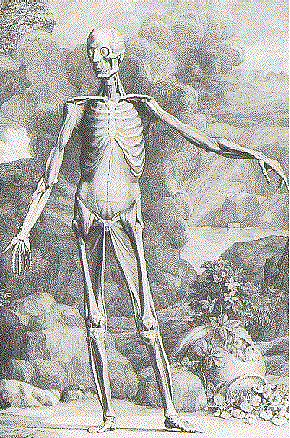 |
 |
 |
 |

Only in the third century BCE did Herophilus of Chalcedon found the first school of anatomy, encouraging his students to overcome their fear of dissecting human bodies. Herophilus himself dissected about six hundred human bodies and wrote a number of anatomical treatises, demonstrating that the brain is the center of the nervous system and showing the distinction between voluntary and involuntary nerves. His contemporary Erasistratus also performed dissections and described the function of number of organs, including the epiglottis and the valves of the heart.
The Greek physician Galen (131-200 CE) used Aristotle's theories in his monumental work De usu partium, which served as a standard medical text for nearly a millennium and a half. Some of his discoveries -- the function of the kidneys, for instance, and the realization that severing the spinal cord causes paralysis -- were advances based on empirical observation. But Galen performed no human dissections, and perpetuated a number of errors. His model of the circulatory system, for instance, although it showed the arteries carried blood rather than air, made the liver the source of blood. His system depended on the coexistence of three "spirits" in the body: the liver was the seat of the natural spirit, the heart of the vital spirit, and the brain of the animal spirit.
The Middle Ages saw the first post-classical medical schools in the West, although their work was rarely grounded in empirical investigation. Most professors did no dissections themselves, leaving the work to their assistants, who were hesitant to disagree with their superiors' pronouncements made on classical authority. Even some of the professors who did their own dissections, such as the fourteenth-century Italian anatomist Mondino dei Liucci, were more ready to trust the Greek, Roman, and Arab medical texts than their own observation. (The most influential of the Arab texts was the Canon of Medicine by Avicenna [980-1037], though he too was often prevented from performing dissections.)
The Renaissance saw a resurgence in interest in anatomy, in part urged by the studies of such artists as Leonardo da Vinci, who demonstrated the homology of muscular structures in humans and animals. The new interest that arose in the sixteenth century began the first systematic, empircal study of gross anatomy, the description of the systems visible to the unaided eye. Still investigations were hampered by concerns about the morality and legality of dissecting human bodies. Andreas Vesalius (1514-1564), for instance, one of the founders of modern anatomy, published On the Structure of the Human Body in 1543 and later received a death sentence under the Inquisition for his anatomizations of human bodies. Andreas's pupils made a number of important advances on his work. The Spaniard Michael Servetus discovered the pulmonary circulation of the blood from the right chamber of the heart to the lungs, and demonstrated that the septum was impermeable. Another student, Realdo Columbus, made important discoveries about the circulation of the blood and respiration, and in fact introduced the term circulation into biological discourse. The English physician William Harvey acknowledged his debt to Columbus in his 1628 Exercitatio de motu cordis et sanguinis (Essay on the Motion of the Heart and Blood).
In the seventeenth century, anatomy (like the other branches of the biological sciences) was aided by the invention of the compound microscope, which allowed investigators to turn their attention from gross anatomy to the structures invisible to the naked eye -- and not only the structures, but their functions. Marcello Malpighi, for instance, extended the work of Harvey to the microscopic level, and studied the oxygenation of the blood in the capillaries in the lungs. The microscopy of Anton van Leeuwenhoek (1632-1723) led to the discovery and description of microorganisms, including bacteria and protozoa. Jan Swammerdam (1637-1680) was the first to observe red blood cells. Robert Hooke's microscopic investigations of cork led him to coin the word cell for the basic unit of life. Eighteenth-century anatomists such as Caspar Friedrich Wolff (1733-1794) and Xavier Bichat (1771-1802) developed Hooke's theories and argued that cells are the building blocks of all organs.
Meanwhile there were important developments in gross anatomy as well. The medical schools of Padua, Bologna, and Leiden were the most influential centers of anatomical research, and the work of Giovanni Battista Morgagni of Padua (1682-1771), Hermann Boerhaave (1668-1738), Joseph Lieutaud (1703-1780), and William Hunter (1718-1783). The first manual on physiology appeared in 1747 from the Swiss anatomist Albrecht von Haller, a pupil of Boerhaave, who followed this work with eight further volumes entitled Elementa physiologiae corporis humani (1757-1766). Antoine Lavoisier combined his extensive chemical knowledge with a firm grounding in anatomy to describe the respiratory process and the production of heat in animals in more detail than had ever been achieved.
By this time the dissection of human bodies was commonplace in medical schools, and the public dissections of murderers and the unclaimed poor drew large audiences. Late in the century, however, there was a public outcry over grave robbing which dampened enthusiasm for some public exhibitions.
The great syntheses of eighteenth-century anatomical knowledge were Buffon's massive Natural History (44 volumes, 1749-1804) and Baron Cuvier's Le regne animal distribué d'après son organisation (9 volumes, 1817-1830).
In the middle 1830s, microscopic anatomy made further advances, largely thanks to the development of the achromatic lens, which allowed for more powerful compound microscopes. Although cell theory had been widely discussed in the seventeenth and eighteenth centuries, it was recognized as the fundamental unit of organization in all living things in 1838 in the work of Matthias Jakob Schleiden and Theodor Schwann.